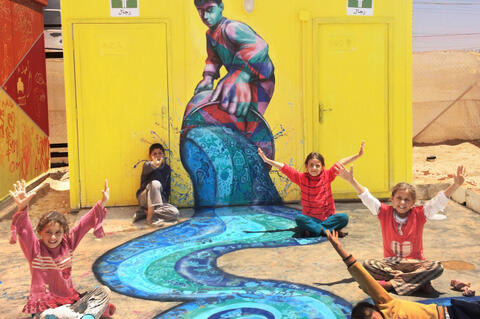Art with Syrian Refugees: The Za'atari Project

"While they have escaped the death and destruction of war, these refugees now find themselves in a colorless desert wasteland that contrasts dramatically with their lush, green native region of Daraa, Syria....There is a lack of arts and culture that enrich the human experience and a no opportunities for refugee voices to reach out to the world in a positive way to tell their own stories."
With the goal of addressing these issues and improving the lives of refugee children in the Za'atari Camp in northern Jordan, artist Joel Bergner traveled to Za'atari in 2013, 2014, and 2015 to partner with a team of Syrian refugees, artists, and educators to lead workshops with children and to make art. Through discussions and artmaking, they learned about water conservation, hygiene issues in the camp, artistic techniques, and conflict resolution, while also exploring social issues, their longing to return to Syria, their dreams for the future, and their plight as refugees. The children had the opportunity to participate and add their own creativity to murals that they created throughout the camp, "adding color and life to the desolate environment and spreading messages of hope to camp residents."
This project uses interpersonal communication and art to give voice to refugee children who are often forgotten about in the barrage of news stories about the Syrian war. It intends to connect these kids to positive adult role models and involve them in educational and creative activities, thereby playing a role in the rebuilding of their communities. For many, this is the only organised educational programme they are involved in. The art itself features positive messages and uplifting imagery.
This initiative emphasises the participation of local artists with the goal of continuing this work in the future. One such artist and educator is Yusra Ali, a Palestinian woman who lives in Mufraq, the town right outside the camp. A lover of art and of working with children, she has led arts and education workshops outside of the project as well. Another participant was Ali Kiwan, a Syrian artist and resident of Za'atari who specialises in classic Arabesque patterns. He collaborated on many murals, combining the traditional patterns with aerosol painting and children's art. Together, Ali and Joel engaged children like the so-called "wheelbarrow boys", who use their wheelbarrows to smuggle goods into the camp, where they are sold on the black market. These kids are not in school and the work is dangerous. To get them involved in positive and educational activities, the project facilitators conducted wheelbarrow-painting workshops. The painting was combined with a variety of other educational activities and mural-making.
Children, Youth, Refugees
The Za'atari Camp is the world's second-largest refugee camp, with approximately 100,000 residents. "With practically no plant or animal life and endless rows of beige tents and caravans, Za'atari is a harsh land of dust storms, heat and blindingly bright sunlight. Lives are on hold and official work is prohibited. Fortunately, Syrians have been greeted by international humanitarian organizations that provide food, shelter, medical care and other basic services. But what about education, jobs, activities for youth, poverty and mental health issues?....There are few structured activities for youth in Za'atari to engage in, and many receive substandard education or do not go to school at all."
Awareness & Prevention Through Art (aptART), Agency for Technical Cooperation and Development (ACTED), the United Nations Children's Fund (UNICEF), the European Commission's Humanitarian Aid and Civil Protection department (ECHO), and Mercy Corps.
"7 Art Initiatives that Are Transforming the Lives of Refugees", by Lauren Parater, United Nations Refugee Agency (UNHCR) Innovation, September 18 2015; and Joel Artista website - both accessed on June 9 2016.
- Log in to post comments
